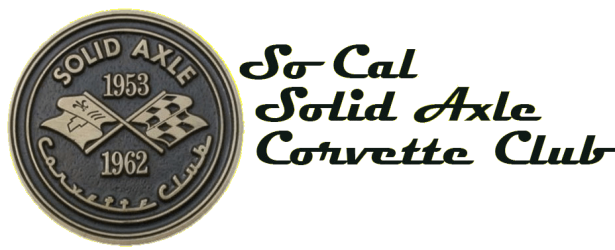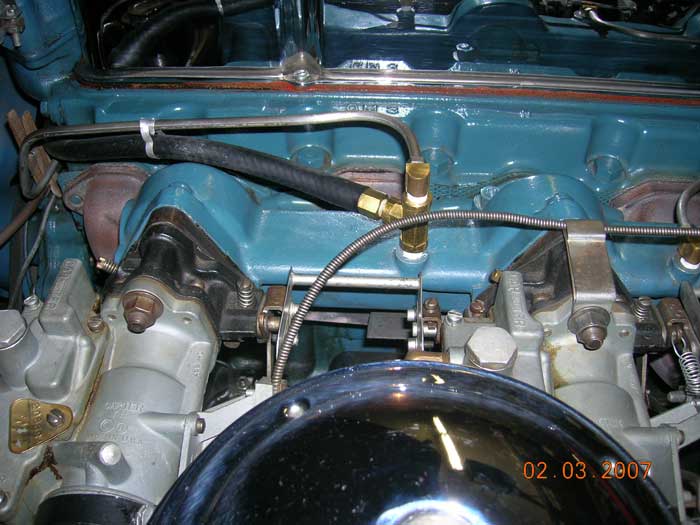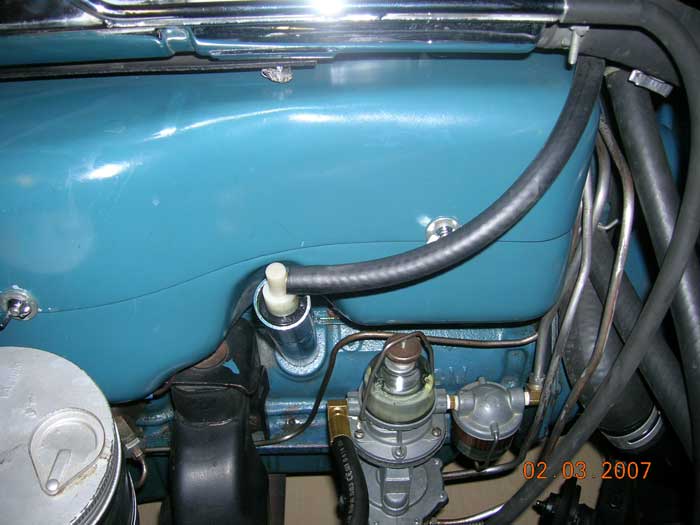1954 Corvette PCV Conversion
submitted by Bruce Fuhrman #2F
1954 CORVETTE PCV CONVERSION
In California a car that is 52 years old is exempt from smog equipment or testing for annual registration. The only regulation is that it must not be emitting billows of white or black smoke. My ’54 was in complete compliance with all state laws.
In June 2003 I joined the Corvette 50th Anniversary Caravan to Bowling Green, KY. As the “senior” car in the contingent from CA, it drew some attention. I am not sure but believe it was the only 6 cylinder Corvette in the Caravan. Some of my Red Line Corvette Club members insisted I be placed in with their predominant line up of C-5’s. This was fine with me! After the first 100 miles or so of desert driving I noticed my companions opting to pass me. It was rewarding since I felt they were impressed how well the old “stove-bolt” 6 ran and were confident I was doing fine by myself. Wrong! After much prodding, I finally got several to confess that “I stunk”! There was no smoke or oil on their windshields but there was quite a pungent odor similar to following an old diesel bus. I also noted that after driving freeway speeds there was white smoke coming from the crankcase vent tube when I stopped for a traffic light. Later on I did want to continue driving in SACC caravans and did not want to offend my “followers” and obviously wanted to do my share to help the environment. So, I decided to see if the car could be adapted to a PCV system.
The car is mostly all stock with matching numbers except for a 12 volt conversion which was necessary for the trip to Bowling Green. Something about starting a 6 volt Corvette in hot weather? I did not want to drill any holes or destroy any original parts.
The best place to catch the crankcase emissions was at the crankcase vent in front of the distributor. Then install a PCV vacuum check valve in the tube and then run a hose to the intake manifold. There are 4 slots in the valve cover which would act is the intake for the vacuum? I sketched this out and was wondering if it would be effective and if the slots were too big in the valve cover. I mentioned the concept to Larry Pearson (SO CAL SACC Secretary) at a board meeting and he said he thought he remembered seeing a Chevrolet Service Bulletin for doing a similar mod on Chevy trucks used in heavy (dusty) farm work. Larry was right and a week later he sent me the information from 1956. The truck and passenger Chevy cars all have one carburetor, different valve covers and intake manifolds. They required some drilling in the valve cover and air filter. See attached R.P.O. #417. The basic principle is the same for recycling the crankcase so I felt my concept should work. I did not want to do any drilling! I was not planning on taking the ’54 on any dusty farm roads.
First remove the crankcase vent assembly which requires some tapping with a rubber hammer from side to side while pulling to loosen the press fit into the block. Once removed, install a steel pipe 1-1/4 “o.d. and 10” long into the hole for the vent tube. Again it will be a press fit.
Next, select a PCV valve from any parts store that will fit a grommet that will snugly fit into the 1-1/4 “ tube. You might take the pipe to the store to assure a proper fit. My selection was for a Toyota. While there pick up 3’ of 3/8” hose for the run from the PCV valve to the manifold fitting.
The vacuum line from the fuel pump which taps in the front of the manifold is removed. A ¼” “T” with 3 internal ports will serve as the connection for the new PCV vacuum line and the reinstalled fuel pump vacuum line. You will also need two ¼” unions to connect the “T” to the manifold and vacuum line. These parts, along with a tube fitting for the PVC hose, are available at any hardware or auto parts store. Thus, no permanent changes are made.
The attached photos depict the final configuration. I have taken the ’54 on numerous caravans and no one has complained about the “odor” and the white vent smoke is obviously eliminated. The car runs fine and with no adverse effects and the environment is cleaner. I can put it back to NCRS status in less than 30 minutes, but I don’t want to!
Bruce Fuhrman
Southern California Solid Axle Corvette Club


